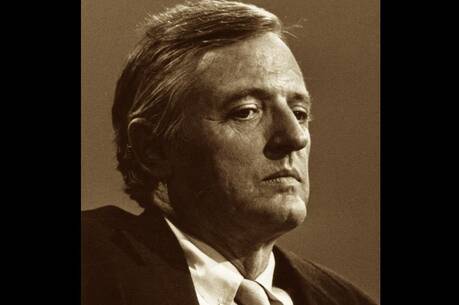Tortured History
Edwin Mellen Press. 309p $149.95
An inveterate skepticism induces gullibility. This is what the publishers of John Cornwell’s Hitler’s Pope counted on when they coupled the title with a dust jacket photograph of Eugenio Pacelli, easily recognizable from his pictures as Pope Pius XII, striding toward a waiting automobile between files of German soldiers in full salute. The title, of course, implied that they were Nazi soldiers. The scandal lay in the fact that the Pacelli pictured there was not a pope and the saluting troops were not Nazis. The photograph was taken before Hitler came to power, at a time when Pacelli was the papal nuncio to President Hindenburg’s pre-Nazi Germany.
In Were the Popes Against the Jews? Tracking the Myths, Confronting the Ideologues (Wm. B. Eerdmans, 405p, $35), George Justus Lawler examines a mass of historical distortions about several bishops and popes that have appeared in the toxic wake of Rolf Hochhuth’s notorious 1963 play, “The Deputy.” Lawler, author of many books and editor of several journals, intimately familiar with the ways of the publishing world, examines several of Hochhuth’s heirs, focusing mostly but not exclusively on David Kertzer’s The Popes against the Jews (2001). Kertzer argues that several modern Popes—culminating with Pius XI and Pius XII—were anti-Semites who paved “the road to the Holocaust.” Lawler, initially beguiled by Kertzer’s argument, became suspicious, re-examined Kertzer’s supporting evidence and discovered “a flood of errors,” “rhetorical subterfuge,” “slanted paraphrase,” “a potpourri of mistranslations…juggled chronology, and… out-and-out falsehoods.” Before he had ever seen the Vatican archives, Kertzer had already made up his mind about the popes, as he made clear in a New York Times op-ed column: “The explanation of what made the Holocaust possible is to be found in no small part in the files of the Inquisition…. “
Lawler repeatedly demonstrates that Kertzer’s accusatory examples—ranging from Vatican support for the myth of Jewish ritual murder or of anti-Semitism based on a form letter sent in receipt for a book expressing anti-Semitism—are demonstrably false or illogical.
Contrary to what gullible cynics might expect, Lawler’s book is no whitewash of the church hierarchy. Kertzer, however, creates a fiction of “aggressive papal support of the hatred that led to the Holocaust” and insists that “a whole-cloth conspiracy against Jews [was] perpetrated by the elders of the Vatican.”
Lawler candidly acknowledges the anti-Semitism expressed by members of the clergy or in Catholic publications (including the Jesuit periodical Civiltà Cattolica). He emphasizes that the Second Vatican Council condemned any persecution or use of force in the name of Christianity and that, as one of its documents states, there is no justification for “having recourse to means that are incompatible with the spirit of the Gospel.” Had Kertzer been less bound to his predetermined view, he might have seen in the statements of those same popes a dynamic moving not toward the Holocaust but instead toward the re-articulation of the principles of the Sermon on the Mount and the Beatitudes.
As Lawler outlines it, papal positions form a trajectory in support of “social justice” and what Pope Leo in the encyclical “Rerum Novarum” referred to as the rights of workers and Pope Pius XII in his 1941 Christmas address as “the rights of man.” Vatican II and subsequent papal statements have further expanded on those “basic gospel principles,” he says, although they are threatened by bishops, and others, who “are fostering prejudice” against homosexuals seeking their rights and women seeking equality in the church. A “dialectical relationship,” as expressed in New-man’s statement, “I shall drink—to the Pope, if you please—still to Conscience first, and to the Pope afterwards,” balancing “authority and private judgment” helps to “rein in warped zealotry.”
President Roosevelt was more reticent than Pius XII when it came to aiding or talking about Europe’s Jews in extremis. In FDR and the Jews (Belknap Press, 464p, $29.95), Richard Breitman and Allan Lichtman, history professors at American University, challenge the view that F.D.R. was remiss in helping them and plot stages in his development from aloofness to engagement. As they point out, F.D.R. was a consummate politician from the first and “carefully walked a line between retaining Jewish support and exploiting upstate [New York] anti-Semitism.” Unlike Kertzer’s misleading contexts, Breitman and Lichtman supply contexts showing the domestic factions faced by F.D.R. Some had a fear of Nazism that was less than their old fear of Communism and saw Hitler as a way to destroy it; others wanted an America isolated from Europe’s war; and still others were anti-Semites, with no interest in hearing about Jewish problems. Attempts to allow Jewish refugees into the United States were met with opposition. Like others, including some members of the church hierarchy, F.D.R. held traditional stereotypes and at first lacked sympathy for requests from Jews for help or statements denouncing the Nazis. In the period before the Nazis halted the emigration of Jews, the United States barred the entry of many of them (while the pope had provided money for fares and encouraged countries on three continents to accept Jewish refugees—a matter outside the scope of and unmentioned in the discussion of F.D.R., despite its telling contrast).
News about the Jews was confusing even in mid-1942, when there were reports—though without verification—of wholesale slaughter in extermination camps. In late summer, the prominent U.S. rabbi Stephen Wise received a telegram from the World Jewish Congress warning that “the Nazis were considering a plan to exterminate 3.5 million Jews with prussic acid….” The State Department continued to believe that Jews were being sent to work camps. Meetings of U.S. Jews called for more “study.” F.D.R. remained cautious about statements singling out Jews as the sole victims and non-committal to Rabbi Wise. In the face of increasing pressure from other Jewish quarters, F.D.R. continued to maintain in late 1943 “his own cautious approach to Jewish issues,” which “very gradually shifted away from the position that only a military victory could save the victims of the Nazi terror” to become more sympathetic to the Zionist project.
Even in his final stage (“late to the task”), F.D.R. “remained cautious about harboring refugees in the United States” (in contrast with Pius XII, who arranged protection for the 80 percent of the remaining Roman Jews, after over 1,000 of them had suddenly been rounded up). F.D.R.’s use of the War Refugee Board and his own second-term initiatives assisted in saving up to 300,000 Jews, still far fewer than the 860,000 Jews cited by the Israeli historian, Pinchas Lapide (“Three Popes and the Jews,” 1967), who were saved by the efforts of Pope Pius XI: “more than all other Churches, religious institutions and international rescue organizations put together.”
Franklin Roosevelt learned much about the horrors of the death camps from a Polish eyewitness. The welcome reissue of Jan Karski’s account of his years in the Polish underground, Story of a Secret State: My Report to the World, (Georgetown University Press, 464p, $26.95, fills out the brief mention of his U.S. president on July 28, 1943—a meeting that may have been instrumental in convincing F.D.R. that the atrocities in the camps were even worse than the wildest rumors about them. Karski himself had suffered first at the hands of the Russians, then the Germans; he was indefatigable, even after having been captured by the Nazis and beaten nearly to death. He simply escaped and rejoined the movement.
In the climax of his exploits, at the behest of the Jewish Bund, he entered a Nazi death camp to become an eye-witness who could take his message to the West. “I was to go on a day when executions were scheduled,” he says, in his matter-of-fact way, entering Belzec wearing an Estonian uniform and with the assistance of one of the Estonian “attendants” bribed by the Bund to serve as a conduit to the prisoners. Overcome after hours of being left alone to watch, the Estonian returned to tell Karski that his open-mouthed daze might give him away. The experience left him vomiting for the next day and night. The farewell celebration included Mass: “quiet and beautiful…. We all took Holy Commu-nion.”
Finally reaching the United States, Karski was received by President Roosevelt, who was eager to hear all about Poland and wanted him to “verify the stories told about the German practices against the Jews.” Breitman and Licht-man give more attention to Wise as the bearer of second and third hand reports than to Karski’s eye-witness testimony.
Even less remembered than Karski are the heroic members of the clergy during the war. In The Catholic Bishops of Europe and the Nazi Persecutions of Catholics and Jews (Edwin Mellen Press, 309p, $49.95), Vincent Lapomarda, S.J., professor of history and a Holocaust specialist at the College of the Holy Cross in Worcester, Mass., focuses on the church hierarchy, while including many other among the clergy and laity who risked or gave their lives in resisting the Nazis and aiding Jews. Lapomarda chronicles scores of bishops and priests, country by country, in a valuable but undetailed study. Particulars are often difficult to come by, since the clergy members who helped Jews sought no publicity and left few traces. He is forthright about those who were less than resistant to the Nazis but concentrates on the many who were heroes. Adding to the book’s value as a resource is a bibliographical essay with country-by-country chapters. Extremely condensed, occasional details are reminders that some bishops also endured the horrors of concentration camps and some were martyred.
Lapomarda’s dry recitation serves the historical record, while Kertzer’s slick presentation promotes historical mystification. The most important of these four books is Lawler’s, but it is seriously marred by a multitude of intermittent faults that dilute its clarity and at moments its coherence.
This article also appeared in print, under the headline “Tortured History,” in the May 6, 2013, issue.











